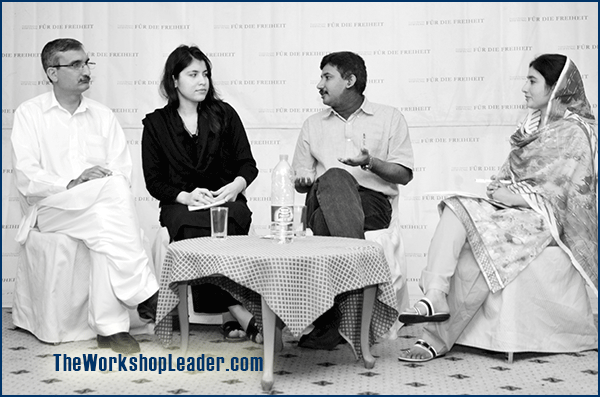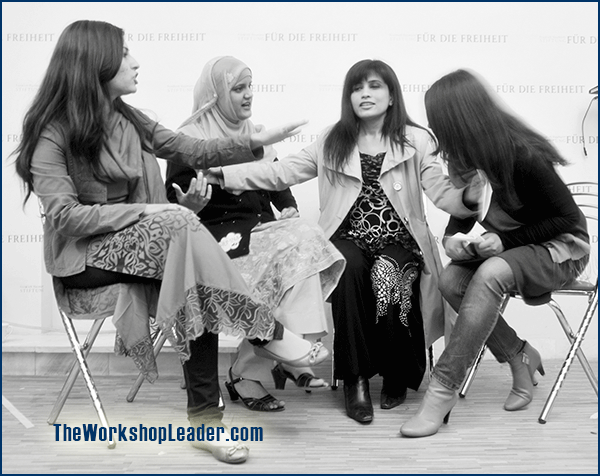A new word is like a fresh seed sewn on the ground of the discussion.
Ludwig Wittgenstein (1889–1951)
Austrian-British Philosopher
Panels are moderated discussions of experts with an audience. You’ll find it in the legal system where the experts are judges. You can see it on television, where the guests are self-declared experts on nearly every topic. You will see it at conferences and seminars where different specialists on a given topic are brought in to speak. So, the art of moderating panels can serve you everywhere.
What is moderation?
In television, the word moderate in its pure sense is often misleading as producers often seek larger audiences by encouraging panellists to fight or even insult each other. In contrast, the aim of a conference is to air different perspectives and opinions so that the audience can make up its mind. It is vital to be prepared. For moderating panels successfully you are knowledgeable about the life and work of your well-selected panellists, have a firm grasp of the topic they will be discussing and have arranged the seating well.

Objective of Moderation Panels
As with everything in life, you need an objective for moderating panels. Why should you commit yourself, your time and energy to organise a panel? What do you want to achieve through it? For example the objective might be: After the conference XYZ (S) 70 per cent of the invited audience (M) have a clear opinion of the topic ABC and and 10 per cent sign up for follow-ups with my organisation (A) if the panel is well-prepared (R) after the panel session of one hour length (T). Did you recognise the SMART in the objective? For more on SMART see Objectives!
All in all you should think of your audience as customer. It’s not about to satisfy the panellists but the audience. Unfortunately, this is often forgotten when you have high-ranking panellists.
More about Objectives of Moderation.
Panelists
In order to have an attractive panel the panelists should be interesting to the audience and, in the best-case scenario, they should attract the interest of an audience by their mere presence. They should be heterogeneous enough to mirror different opinions and backgrounds to have a vivid discussion, but homogeneous enough not to kill each other on the stage. That means they accept and respect each other. The ideal number is around four to five experts. Ensure that you achieve a gender balance and perhaps one or two younger panellists, whose views are often more interesting than those of the usual old boys’ club.
Furthermore, you have to know your panellists. This is important so that you can compose a balanced panel but also so that you can introduce them effectively [see host] and give the audience an idea of their background. Make sure that you ask beforehand for the correct pronunciation of their names and job titles. Write your introductions on cards so that you do not forget any important details under pressure.

Preparation
For moderating panels you don’t have to be an expert in the topic, which is being discussed. Nonetheless, you need to know some basics as well as the current debates and issues in order to properly prepare your questions. To do this thoroughly, at least one full day of research will be required. The best method is to distil the results of your research on a few cards so that you can recall them before the panel starts.
Think of between three to five questions for each expert. You could divert from them in the course of the discussion, but you must ensure that don’t find yourself in a situation in which you have nothing to ask. The first round of question serves to warm-up the panel.
PP or not PP?
Although I am a fan of visualisations and a well-prepared PowerPoint could help the audience, it often doesn’t. This is because, very few people master the Art of Presentation. Panellists don’t stick to the allotted timing, have too many slides, and are usually too verbose. However, if you allow one panellist to present with multimedia then you must extend the same courtesy to all of them. To sit on the stage as an expert and learn only then that you could have prepared a visual presentation is not fair.
As the moderator, you could have one slide per panellist during your introduction of each. Furthermore, you could introduce to the topic with basic information to bring the audience up to a certain level — perhaps ending with the first question. This also presents another chance for you to brand yourself and build perhaps a new career.
Seating Arrangements for moderating panels
The seating arrangement is crucial in framing the process and the outcome of the panel. Compare the following seating arrangements displayed from a bird’s-eye view. The one you choose will depend on your expected outcome: do you want the moderator to be the mediator between interview partners and the audience or do you want to make a pro-contra discussion? Do you fear that you have to separate opposing candidates? In any case: sitting amongst the panellists allows the moderator to intervene just with body language, e.g. when their speaking time is up, or when they have to let another panellist finish his speech without interruption.
Another way of moderating a panel is the Fishbowl. This arrangement places far more pressure on the panellists and the audience feels freer to join and ask questions. For this reason, it is the favoured choice of many liberals though it’s hard to set up in a hotel.
Logistical Set-up
For moderating panels some logistics should be taken care of. If you have a larger audience, i.e. more than 20 people, a sound system should be arranged. Besides the microphones on the stage there should be two assistants with additional microphones for the question and answer session. Depending on the audience it is often a good idea for the assistants to hang onto the microphones because members of the audience can sometimes start their own 20-minute presentation as soon as they have a microphone in their hands.
The alternative is to set up a microphone on a tripod in the middle row, for example, and participants with questions line up. The advantage is that they feel some pressure to keep themselves short when there is a queue behind them.
Lighting is an easy thing to overlook. The room should be well balanced and the panel easily visible. On the other hand, panellists shouldn’t be blinded by the light as they also want to see the audience especially during Q&A sessions. It gets even more important to have an assistant to assist with lighting when you switch between a multimedia presentation and panel discussion.
Leader on stage
You are the leader on the stage while moderating panels. Your preparation and seating arrangement will help you to achieve your objectives. But be aware that the panel is not about you. Make everyone else look intelligent, both the panellists and the audience. Don’t forget, however, that you are mainly the advocate of the audience. You are not there simply to be nice to your panellists. You could interrogate them hard to extract information instead of letting them promote themselves.
For your opening you could use an actual event or a latest incident that everybody is concerned about. And of course you’ll introduce your panelists [see above].
You should ensure that the event sticks to schedule so that the panellists and audience are not unexpectedly delayed. However, you will also have to give an equal opportunity to speak to all panellists. Otherwise, the audience will have the impression that you are biased. It is crucial that you avoid this perception, as you are a neutral party, who doesn’t take a position on the issues at hand.
Your task is to ensure equal participation and to keep your panellists on topic. In addition to the seating arrangement, your body language and especially your Art of Questioning [see Moderation Techniques] will help you to achieve these aims. But also allow the panellists to talk to each other. You should never have more than ten per cent of the overall time.
After the discussion, you will be expected to sum up the key areas which were covered. You can ask for a final single-sentence statement from each of the experts on the panel. To do this you could explicitly ask them, ‘How would you summarise your final position in a single sentence?’ This will make it easier for you to outline your final summation.
Don’t forget to thank the panellists who have participated as well as the audience who have spared their time. In case you have support staff don’t neglect them either.
It is good form to thank the panellists later by letter a few days after the panel. If you have photos of the event, you should enclose them.
Q&A
The involvement of the audience should be around one third. That means for 30 per cent of the time the audience should be asking questions and receiving answers. When moderating panels, plan the initial panel discussion with this in mind.
Ask participants to give their title and affiliation before asking their question. Make sure they understand that it is a question and answer session and not a presentation and answer session and they should restrict themselves to a quick question. Ideally, they should say which of the panellists they want to answer from.
If you get the feeling that there is much more people want to discuss or to follow up with, suggest another event to continue the discussion. If you have prepared thoroughly, all the participants will have been registered and you can send them invitation to a seminar on the topic or a specialist conference. A useful tool for this is Open Space, which allows you to gather input from the audience. It is sometimes the case that the greatest expertise lies with those who are watching the panel rather than those participating in it.
Streaming, Twitter and other Opportunities
With live streaming you enable a much wider audience to follow the discussion. If there is a videoconference installed an audience from different cities or even countries could participate fully. You reduce travel costs and visa problems.
Another way to get more questions from around the globe or just your country is a twitter blog in addition to live streaming. This is a little easier to handle than a videoconference. Nonetheless, you’ll need an assistant who screens the incoming messages for interesting questions.

